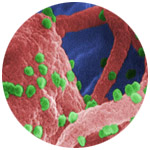|
d. HIV/AIDS and Sexually Transmitted Infection (STI)
|

|
HIV/AIDS, commonly referred to as the “silent epidemic,” has reached pandemic proportions. In 2009, 33.3 million people were estimated to be living with HIV/AIDS (World Health Organization and UNAIDS 2010). Sub-Saharan Africa remains the most affected region. More than two-thirds (68%) of all HIV-positive patients live in this region, making up more than three-quarters (76%) of all related deaths. HIV/AIDS alone or in combination with other STIs contributes to the emergence of AMDR (Savona 2010) and are more likely to seek treatments and use antibiotic preparations.
Table 1. Global Burden of HIV/AIDS in 2009 (in millions)
|
Region
|
Adults & children
living with HIV/AIDS
|
Adults & children
newly infected
|
Adult prevalence*
|
AIDS-related deaths in
adults & children
|
|
Sub-Saharan Africa
|
22.5 million
|
1.8 million
|
5.0%
|
1.3 million
|
|
North Africa & Middle East
|
460,000
|
75,000
|
0.2%
|
24,000
|
|
South and South-East Asia
|
4.1 million
|
270,000
|
0.3%
|
260,000
|
|
East Asia
|
770,000
|
82,000
|
<0.1%
|
36,000
|
|
Oceania
|
57,000
|
4500
|
0.3%
|
1400
|
|
Central & South America
|
1.4 million
|
92,000
|
0.5%
|
58,000
|
|
Caribbean
|
240,000
|
17,000
|
1.0%
|
12,000
|
|
Eastern Europe & Central Asia
|
1.4 million
|
130,000
|
0.8%
|
76,000
|
|
North America
|
1.5 million
|
70,000
|
0.5%
|
26,000
|
|
Western & Central Europe
|
820,000
|
31,000
|
0.2%
|
8500
|
|
Global Total
|
33.3 million
|
2.6 million
|
0.8%
|
1.8 million
|
*Proportion of adults aged 15 to 49 years who are living with HIV/AIDS.
(Source: UNAIDS. www.unaids.org. November 2010)
Southern Africa accounts for 35% of all people living with HIV, with almost one-third (32%) of all new HIV infections and AIDS deaths. In contrast with other regions, the majority of people living with HIV in sub-Saharan Africa (61%) are women. Infections with HIV in Ugandan infants despite nevirapine prophylaxis correlated with the length of the treatment regimen (Church et al. 2008). In Cameroon, more than 90% of patients with HIV resistance had strains that were also resistant to nevirapine-efavirenz and lamivudine-emtricitabine (Kouanfack et al. 2009). The association of HIV/AIDS and extensive drug resistance results in high mortality (Gandhi et al. 2006).
In North America, the prevalence of transmitted resistance to antiretroviral drugs has been estimated to be between 1% and 11% among newly infected patients (Little et al. 2002). Overall prevalence of HIV strains resistant to 1 or more drugs is on the rise (Scott et al. 2004), especially in smaller clinical centers.
In Europe, 1 in 10 antiretroviral-naive patients carried viruses with more than 1 drug-resistance mutation. Newly infected patients harbored resistant variants more often than did chronically infected patients (13.5% vs 8.7%, respectively). Non–subtype B viruses (30%) carried resistance mutations less frequently than did subtype B viruses (4.8% vs 12.9%, respectively). Baseline resistance increased over time in newly diagnosed cases of non–subtype B infection—from 2.0% in 1996–1998 to 8.2% in 2000–2001 (Wensing et al. 2005).
It is estimated that 76% of viremic patients are resistant to 1 or more antiviral drugs, with the odds of resistance increasing in the presence of a history of antiretroviral drug use, advanced HIV disease, higher plasma HIV viral load, and lowest CD4 cell counts (Richman et al. 2004). Between 1987 and 2003, 10.3% of seroconverting patients carried a drug-resistant primary human immunodeficiency type 1 (HIV-1) variant (Masquelier et al. 2005). Of those, 9.1% showed resistance mutations to only 1 class of antiretroviral drugs, 0.5% to 2 classes, and 0.7% to 3 classes of antiretroviral therapy.
|



